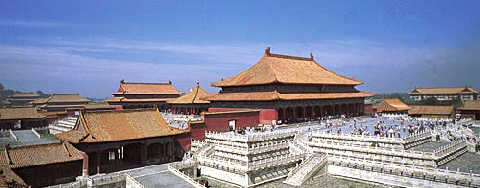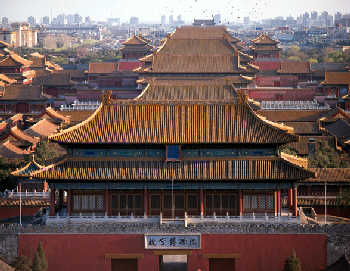

Beijing was transformed on the basis of the metropolis of the Yuan Dynasty. The city was in a slightly horizontal square shape. It stretched 6,650 meters from east to west, and 5,350 meters from north to south, with brick city walls on all sides. It consisted of nine city gates, outside each of which there was a weng cheng (earthen-jar city). On the city gate was a two-layered three-eaved tall building. On the Weng Cheng was a four-layered embrasured watch tower, with walls laid with bricks, making it look very magnificent and solid. In the southeast and southwest corners of Beijing, there were also gauge-shaped plane corner towers, also of four layers laid up with bricks. Only Zhengyangmen, in the middle of the south city wall, the front gate of its Weng Cheng, the tower of Weng Cheng in Deshengmen and the southeast corner tower, remain.
The Forbidden City, located in the center of the axial line, stretches760 meters from east to west and 960 meters from north to south, with its size accounting for only a little over one-sixth of Taijigong city in Chang'an of theTang Dynasty. On the northernmost end of Forbidden City was a built-up 50 meter hill called Zhenshan (also called jingshan),with the implication of suppressing the imperial air of the Yuan Dynasty. At the bottom of the hill was a Yuan Dynasty palace. The bigpavilionbuilt at the center of the hill was the commanding height of the whole city and the plane geometric center To the north of jingShan, the Drum and Bell towers along the axis face jingshan from afar.
In order to strengthen Beijing's defense, theMing Dynastyplanned to build an additional ring of outer city walls. The project began from the more populous south, but as the remaining parts of the project on the three other sides were never constructed, Beijing finally became a convex-shaped plane. The newly added city walls on the southern side were called the outer city. The original city was renamed the inner city. In the southern part of the outer city was Tiantan, or theTemple of Heaven. To the north of the inner city was Ditan (terrace), to the east the Ritan and west Yuetan, forming the four perpheral key points, clustering round the imperial city and the palatial city at the center.Taimiao(the Imperial AncestralTemple) and Sheji Tan (thealtarfor worshipping god of the land and worshipping god of grain) was located on the left and right sides in front of Wumenin the front gate of the palatial city, adjacent to the Imperial Palace.

Copyright ©1999-2011 Chinanews.com. All rights reserved.
Reproduction in whole or in part without permission is prohibited.